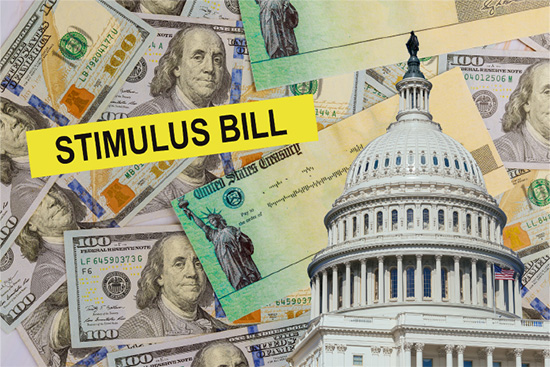What the Second Covid Stimulus Bill Means for Your Personal and Business Finances
By Jesse Giordano, CFP® | December 29, 2020A second Covid-19 relief package has officially been signed into law. This follows the $2.2 trillion CARES Act that was approved this past spring. The new $900 billion bill includes another round of stimulus checks and unemployment aid, among other benefits. It’s a lot to digest, and if you’re like most Americans, you may be curious about how it will all affect you.

We’ve pulled out some of the key points below to help you understand how this new bill could potentially impact your finances. Here’s a brief but thorough breakdown of what you can expect.
Another Round of Stimulus Checks Are Being Rolled Out
The CARES Act sent $1,200 to many individuals, plus an extra $500 for each dependent child in the household. The new bill includes smaller payments ($600 for qualifying individuals) but does increase the amount for dependent children to $600. That means a family of five could receive up to $3,000. However, there is still a possibility that these federal direct payments could go up from $600 to $2,000 per qualifying person. The House recently voted for the increase, packaged in a new bill called the CASH Act, leaving the decision in the hands of the Senate at the time of this writing. We’ll have to wait and see if they’ll indeed take up a vote before the year ends.
As the current law states, there are income thresholds for direct payments based on your 2019 adjusted gross income. Folks who earned up to $75,000—or $150,000 for married couples—will be eligible for the full amount, but direct payments begin to phase out for higher earners. Individuals who earned over $87,000 will be ineligible for the second stimulus check altogether. The same goes for married couples who earned more than $198,000. For everyone else, recipients who are enrolled in direct deposit with the IRS could begin receiving payment within the coming weeks.
Unemployment Benefits Are Being Extended
The new stimulus bill includes a federal unemployment benefit that will deliver $300 weekly for a minimum of 10 weeks, providing relief through mid-March 2021. While the CARES Act provided an extra $600 per week, it’s still something to help tide people over. This money is in addition to regular state benefits, along with any aid being provided through the Pandemic Unemployment Assistance Program. The latter, which had previously expired on Christmas weekend, is geared toward self-employed workers who don’t qualify for traditional unemployment benefits.
More Aid Is Coming to Small Businesses
Small business owners who are still struggling with declining revenue because of the pandemic can now access more aid. The new stimulus bill includes $285 billion for new loans, thus reviving the Paycheck Protection Program for a second round. This will provide loans up to $2 million that are forgivable if at least 60 percent of the money is used to cover payroll. The rest can go toward things like rent, utilities, and other eligible expenses. One catch is that applicants can’t have more than 300 employees. They also must show that they’ve experienced at least a 25 percent decline in revenue in any 2020 quarter when compared to the same period in 2019.
That said, previous borrowers will now have the opportunity to borrow money a second time if they meet the eligibility requirements. That’s big news for small business owners who are still struggling, especially folks in the food services industry. Under the second round of PPP funding, hotel and restaurant owners may be able to receive loans equal to 3.5 times their average monthly payroll expenses. This is up from 2.5—a sizeable and much-needed jump.
Small business owners will also be granted an expanded Employee Retention Tax Credit. This refundable payroll tax credit originally applied to qualifying business owners who experienced a significant decline in year-over-year quarterly revenues in 2020. The new stimulus bill will now apply this tax credit to the first half of 2021. It also features looser eligibility criteria, making it easier for small businesses to qualify. What’s more, the maximum benefit is getting a major bump. Under the new bill, eligible businesses could potentially receive a tax credit of up to $7,000 per employee per quarter.
You Can Deduct More in Charitable Donations in 2021
The CARES Act made it possible to deduct up to $300 for qualified charitable donations made in 2020, even if you choose not to itemize your deductions. The new stimulus bill is carrying that over into 2021—except joint filers will now be able to deduct up to $600 in donations. This, in turn, can lower your taxable income. At the same time, it incentivizes helping non-profit organizations that desperately need donations during the pandemic. It’s a win-win.
Flexible Savings Account (FSA) Balances Can Now be Rolled Over
FSA balances are usually structured in a use-it-or-lose-it way. However, the latest stimulus bill will allow you to roll them over into 2021. Whatever is not used at the end of 2021 can also be rolled into the following year. This translates to financial relief, particularly for those who use an FSA to offset child care or health care expenses.
Another positive detail of the new stimulus bill is that it earmarks $48 billion for vaccines. This includes purchasing and distributing them, as well as assisting states with their test-and-trace efforts. Money is also being set aside for federal coronavirus research.
The new Covid-19 relief bill is a complex and comprehensive piece of legislation that is anything but simple. There are many moving parts to consider, especially with regard to your unique financial situation and long-term goals. We’ve got your back and are here to help you understand all the important details. Contact us today to begin charting your course and planning for the future.
Be a Smart Investor
Stay up-to-date with industry-leading information and news delivered straight to your inbox.
Get our timely insights delivered to your inbox (Blog)
Please remember that past performance may not be indicative of future results. Different types of investments involve varying degrees of risk, and there can be no assurance that the future performance of any specific investment, investment strategy, or product (including the investments and/or investment strategies recommended or undertaken by Opal Wealth Advisors, LLC [“OWA]), or any non-investment related content, made reference to directly or indirectly in this commentary will be profitable, equal any corresponding indicated historical performance level(s), be suitable for your portfolio or individual situation, or prove successful. Due to various factors, including changing market conditions and/or applicable laws, the content may no longer be reflective of current opinions or positions. Moreover, you should not assume that any discussion or information contained in this commentary serves as the receipt of, or as a substitute for, personalized investment advice from OWA. OWA is neither a law firm, nor a certified public accounting firm, and no portion of the commentary content should be construed as legal or accounting advice. A copy of the OWA’s current written disclosure Brochure discussing our advisory services and fees continues to remain available upon request or at www.opalwealthadvisors.com. Please Remember: If you are a OWA client, please contact OWA, in writing, if there are any changes in your personal/financial situation or investment objectives for the purpose of reviewing/evaluating/revising our previous recommendations and/or services, or if you would like to impose, add, or to modify any reasonable restrictions to our investment advisory services. Unless, and until, you notify us, in writing, to the contrary, we shall continue to provide services as we do currently. Please Also Remember to advise us if you have not been receiving account statements (at least quarterly) from the account custodian.



